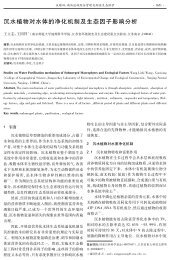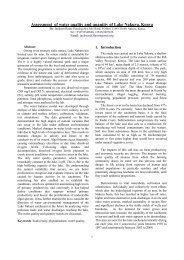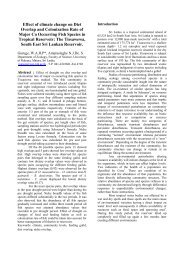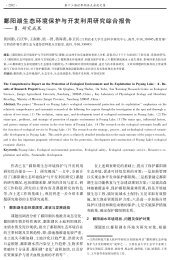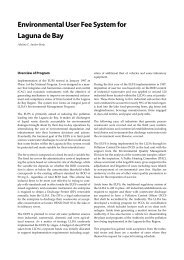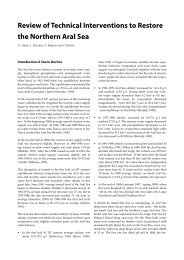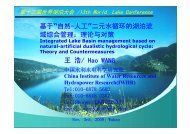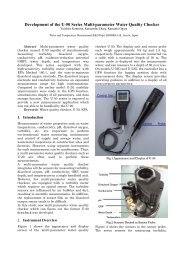Predictive Hydrodynamic and Eutrophication Modeling of Lake ...
Predictive Hydrodynamic and Eutrophication Modeling of Lake ...
Predictive Hydrodynamic and Eutrophication Modeling of Lake ...
Create successful ePaper yourself
Turn your PDF publications into a flip-book with our unique Google optimized e-Paper software.
outflow, rainfall <strong>and</strong> evaporation. In general,both the model results <strong>and</strong> observed data show adecreasing trend in elevation from January toJuly, then the elevation tends to rise from July toOctober, then the temporal trend level-<strong>of</strong>ftowards the end <strong>of</strong> the year, which reflects theintra-annual precipitation distribution wheremajority <strong>of</strong> the rainfall occur during the summerin this area. The hydrodynamic model was alsoevaluated by its simulated circulation pattern inFigure 3. Apparently, the model results showthat the circulation in the lake is dominated by acounter-clockwise flow filed while local microcirculationpatterns do exist, which matches thepast knowledge about the circulation in <strong>Lake</strong>Dianchi based on historically measured data.Both the elevation <strong>and</strong> circulation pattern resultssuggest that the hydrodynamic model likely hasrepresented the hydrologic balance <strong>and</strong> fluiddynamics well, serving a reasonable basis forfurther water quality modeling.After the hydrodynamic model was calibrated,the water quality simulation was turned on tosimulate the nutrient, phytoplankton, DO <strong>and</strong>water column-sediment interaction dynamics.The simulated water quality was compared withobserved data, <strong>and</strong> key kinetic parameters wereadjusted until a reasonable match between modelresults <strong>and</strong> data were achieved. Figures 4 to 6plot simulated NH4, DO, TN, <strong>and</strong> TPconcentrations against observed data at threemonitoring stations in <strong>Lake</strong> Dianchi. As shown,the model has reasonably reproduced both thespatial <strong>and</strong> temporal patterns <strong>of</strong> the observeddata. As shown in Figures 4 <strong>and</strong> 5, NH4concentration drops sharply during the first threemonths, which was likely caused by the lack <strong>of</strong>sufficient inflow loading to <strong>of</strong>fset theconsumption by an early spring algal bloom inthe lake. Accompanying the sharp drop in NH4,we can observe in both the model results <strong>and</strong>measured data that DO tend to increase for thatperiod, which also suggests a likely spring algalbloom.Figures 4 to 6 demonstrate that during thesummer period, DO concentration can rise tovery high level well above the saturation level.This is caused by the intensive summer algalbloom in the lake. Comparing the magnitude <strong>of</strong>summer DO at the north lake stationHuiwanzhong <strong>and</strong> that at the south lake stationHaikouxi, it is obvious that the peak DO value atthe north lake is significantly higher than that atthe south lake, suggesting a more intensive algalbloom in the north lake. This pattern agrees withthe general observation in <strong>Lake</strong> Dianchi, <strong>and</strong> canbe explained by the high nutrient input loadingfrom Daqinhe River <strong>and</strong> Panlongjiang River.During the dry period, the loading signal fromthe tributaries is significant only at the north lakestation Huiwanzhong. However, during the wetperiod, we can observe spikes <strong>of</strong> increasednutrient concentration at all the stations. It isinteresting to note that after watershed loadingscaused a spike in NH4 concentration, the spikewould turn into a sharp downtrend until anexternal loading event produces another spike.The downturn <strong>of</strong> NH4 following a spike is anindicator <strong>of</strong> stimulated algae activities caused byincreased nutrient concentration, which quicklyuptake inorganic nutrient <strong>and</strong> depleteconcentration in the water column. Thesephenomenon clearly indicate that the waterquality in <strong>Lake</strong> Dianchi is significantly impactedby the watershed loading, <strong>and</strong> the temporaldistribution <strong>of</strong> incoming loading largelydetermine how the lake water quality vary overtime.In summary, the model in general catches thespatial <strong>and</strong> temporal distribution <strong>of</strong> water qualitywell, suggesting it likely to be a reasonablenumerical representation <strong>of</strong> the prototypesystem. The model-data comparison does showminor disparity between the model result <strong>and</strong>data at certain locations <strong>and</strong> times, which can beattributed to the uncertainty in both the model<strong>and</strong> data. Future research will be targeted tocollect more data to characterize the incomingloading as well as the in-lake water qualitypattern. Particularly, a more accurate watershedmodel is anticipated to be developed to providemore robust boundary condition than does theGWLF model.Preliminary Model ApplicationThe purpose <strong>of</strong> a hydrodynamic <strong>and</strong> waterquality model is to serve as a platform forevaluating various water quality restorationschemes. In this study, the model was applied toconduct a preliminary scenario analysis throughsimulating how the in-lake algal bloom intensityresponds to load reductions at all the tributariesexcept for Daqinghe River <strong>and</strong> PanlongjiangRiver. The purpose is to illustrate how the loadreductions at discrete tributaries would haveimpact on the algal bloom intensity in the lake.To execute such an analysis, a baseline scenariowas formulated which was based on the existingloading level as in the calibration model, butrecycling the boundary conditions for 20 years to



